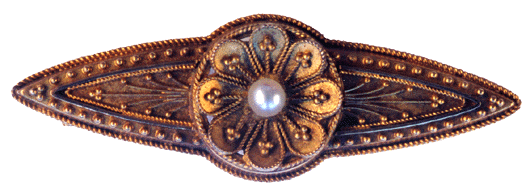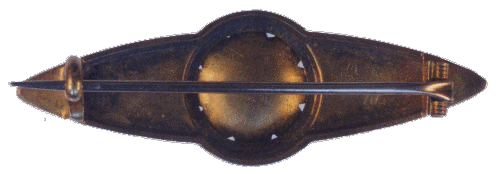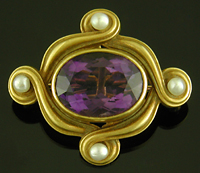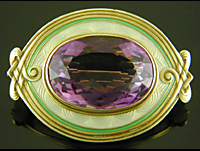
Victorian Etruscan Revival Pin |
|

Secrets of the Ancients! |
|
|
The Etruscan civilization flourished along the western coast of Italy during the period 500 BC to 300 BC. Among the arts perfected by these ancient peoples was a mastery of gold working and the arrangement of minute golden beads into beautiful, textured designs and patterns - a technique known as "granulation". As the Etruscan civilization faded, the secrets of granulated gold work were lost.
In the early 1800s an Italian jeweler, Pio Castellani, became entranced with the timeless beauty of Etruscan jewels. He resolved to rediscover the lost art of granulation. Although he never fully recreated the ancient Etruscan methods, he succeeded in creating jewels that captured the beauty and spirit of the ancient civilization. His efforts sparked the mid-Victorian jewelry style known as the Etruscan Revival. Pictured above is a beautiful example of a Victorian pin crafted in the Etruscan Revival style. Created around 1870, this pin is a wonderful display of the goldsmith's artistry and the granulation technique. Each of the tiny beads of gold was painstakingly positioned by hand and then soldered into place. The result is an enchanting tapestry of flower-like and geometric designs. The creator of this jewel employed a second ancient decorative device - twisted gold wires. The gold wires have been used to frame the gold beads and to suggest the stems and stamens of the floral designs. Although twisted-wire work is sometimes referred to as "mock granulation", it is a beautiful decorative technique in its own right. In the center of the pin, a small round pearl is set in a concave well. The sides of the well are decorated with gold beads and twisted-wire work to suggest a beautiful flower with eight petals. Within each petal are three balls of gold atop a gold wire-twist stamen. Imagine the extraordinary patience and craftsmanship required to create this lovely jewel! Cost: Although this beautiful brooch has sold, you will find many more fine brooches in the Antique Brooch Gallery. |
|
|
|
|
|
The above three-quarters view of the pin highlights each gold bead and strand of twisted wire. Each golden element has been precisely positioned and securely attached to the jewel. This view also shows the depth and three-dimensionality of the brooch. Note the beautiful arrangement of the design motifs in tiered layers - this "layering effect" is characteristic of the Middle Victorian period (1860 to 1881) when jewelers were often inspired by Classical architecture. Also note the jewel's thick walls and apparent weightiness. During the early Victorian period gold was relatively scarce and gold jewels were usually light and airy. However, after the gold finds in California (1849) and South Africa, gold jewels became heavier and more solid, like our Etruscan Revival pin. |
|

|
|
|
This rear view of the our Etruscan Revival pin shows the "C" clasp characteristic of the Victorian and earlier periods. Also, note the sturdy, coiled-wire hinge securing the pin stem. When considering a brooch or pin always closely examine the clasp and hinge. These are the "working" parts of the jewel and are subject to the greatest wear and tear. The clasp and hinge of this pin are in excellent condition, even after 130 years of wear. The rear view also shows the sturdy sub-structure that the goldsmith created to securely hold the delicate elements - gold beads and twisted-wire work - on the front of the pin. This attention to detail and craftsmanship is why this jewel has survived for 130 years and will be just as beautiful after another 100 years. We should look so good after a century of wear and tear.
|
|
| |
||
| Antique Jewelry Gallery Antique Brooch Gallery If you have any questions, suggestions or comments, I can be reached at 978 525-8951 or arthur@jewelryexpert.com.
|
||
|
|


